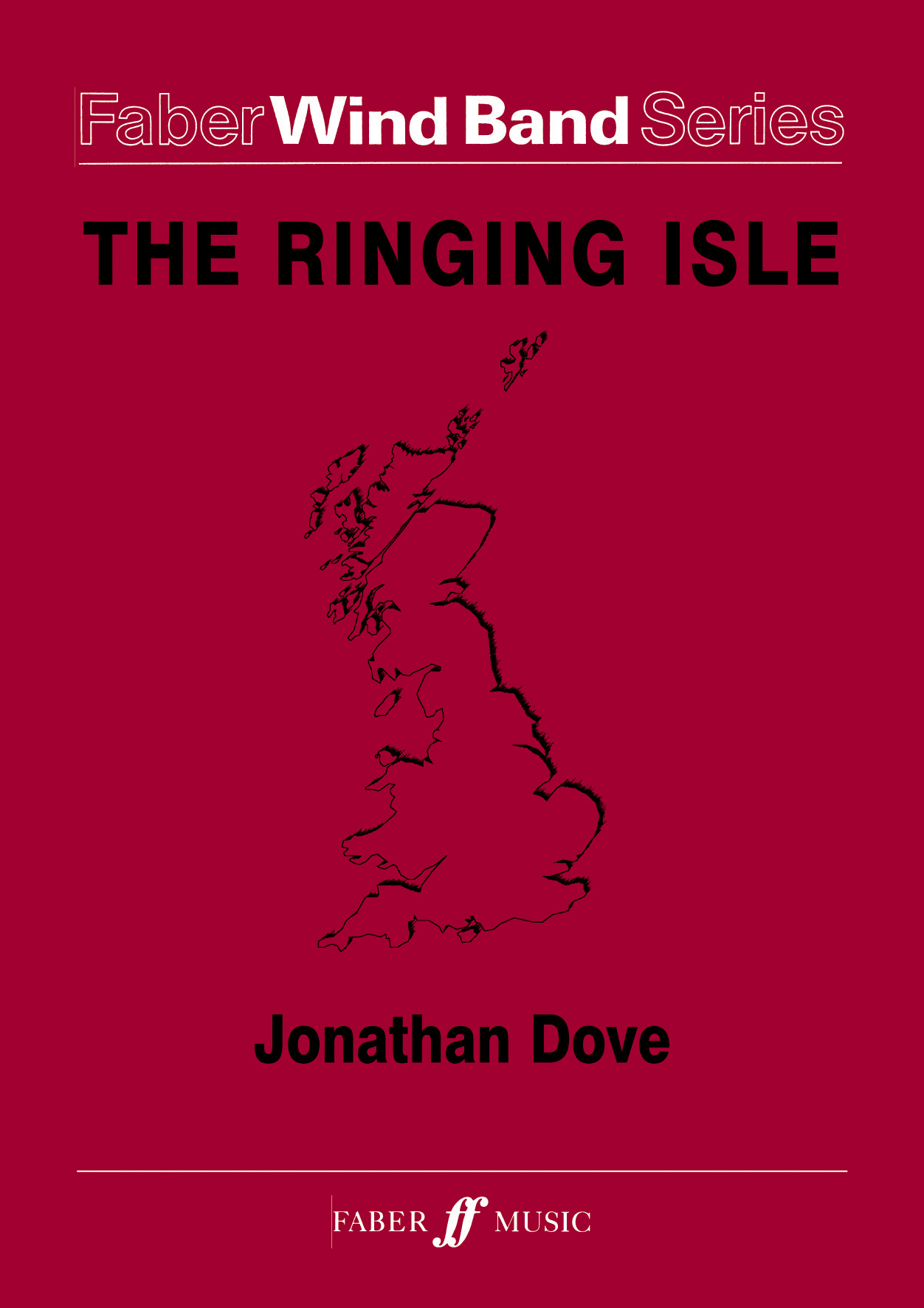Results
-
£13.95
The Proclamation of Christmas - Score only - Stephen Bulla
Program NotesOriginally written as the 'show opener' for one of The Salvation Army's spectacular annual Christmas Carol concerts in London, and premiered by The International Staff Band, Stephen Bulla's overture The Proclamation of Christmas is an extended work that features a number of popular Christmas tunes, including Hark The Herald Angels Sing, Ding Dong Merrily on High, and The First Nowell. There are also two slightly less well-known tunes that are linked to the carols - While Shepherds Watched and Angels from the Realms of Glory - and the piece concludes with a final flourish from O Come, All Ye Faithful.Its dramatic opening and imaginative structure make it a rewarding piece to rehearse and perform, and it certainly fulfills all the requirements of a Christmas show opener! So, we firmly believe that this overture will be a popular addition to Christmas repertoire for concert band in the same way as it was in its original version for brass band.
Estimated dispatch 7-14 working days
-
£65.00
The Ringing Isle - Jonathan Dove
Handel called Britain 'the ringing isle' because when he moved to London, he heard bells ringing everywhere: great bells in church towers, and handbells in some of the first private houses he visited. The sound of people 'ringing the changes' is a peculiarly British sound of celebration, and it seems a good starting point for a piece celebrating British musical life. Within The Ringing Isle, Dove incorporates some traditional change-ringing patterns, from 'Grandsire Doubles', 'Oxford Treble Bob Minor' and his own version of 'Plain Bob Major'. Handel's phrase also conjures up an image of a magical island, and so this is how Dove envisaged how it must have been to approach Britain from an ocean voyage.
In stock: Estimated delivery 1-3 days
-
 £41.11
£41.11Christmas Processional - Wind Band (French Trad. arr. Andrew Wainwright)
A spectacular opener to any Christmas concert, based on the French carol, Bring a torch, Jeanette, Isabella. This work tells the story of a group of children in medieval Provence, dressed up as shepherds and milkmaids, carrying torches and candles as they proceed to the stable. As they draw closer and their excitement increases, they are constantly reminded by their parents to keep the noise down so that they don't wake up the baby Jesus. The music begins quietly and builds to a majestic conclusion. "If I were still conducting regularly, this would certainly be on my list as a Christmas concert opener - it sets the energy and mood most effectively. The scoring is terrific." Paul Hindmarsh, music critic PDF download includes score and full set of parts. Sheet music available from : UK: www.wind-band-music.co.uk USA: www.solidbrassmusic.com Difficulty Level: Medium Advanced Instrumentation: Flute 1-2 Oboe 1-2 Bassoon 1-2 Clarinet in Bb 1-3 Bass Clarinet in Bb Alto Saxophone Tenor Saxophone Baritone Saxophone Trumpet in Bb 1-3 Horn in F 1-4 Trombone 1-2 Bass Trombone Euphonium Tuba Double Bass Timpani Percussion 1-3
In stock: Estimated dispatch 1-3 days
-
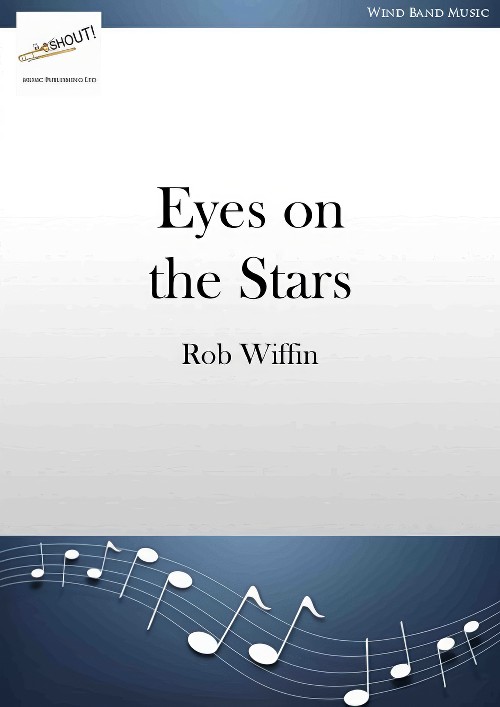 £44.95
£44.95Eyes on the Stars (Concert Band - Score and Parts) - Wiffin, Rob
Eyes on the Stars was commissioned by the Surrey Police Band in 2022 in memory of George Rowland. George was a remarkable character. He was born in Vienna but spent his early days in Tuscany, coming to England with his family at the start of WW2, where he went on to be one of the pioneers of cancer research. He was an avid skier, tennis player and extremely keen musician. Wherever he went he joined a community band so when he and his family settled in Surrey he joined the Surrey Police Band. To them he was George who played bass clarinet, a polite chap with a lovely deep Surrey accent! In trying to fulfil the terms of a commission for a five-minute work I attempted to embrace the verve and aspirational nature of George and his overwhelmingly positive nature, hence the title Eyes on the Stars.- Rob WiffinFirst performed by the Surrey Police Band on 18 March 2023 at Emmanuel Church in Stoughton.Duration: 5.15
Estimated dispatch 7-14 working days
-
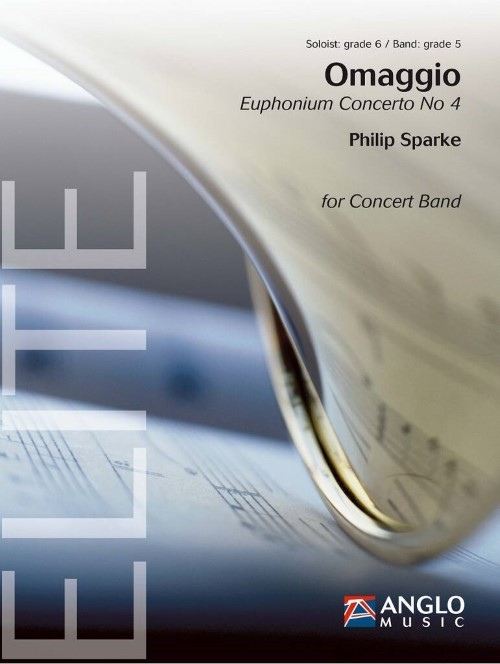 £206.99
£206.99Omaggio (Euphonium Concerto No.4) (Euphonium Solo with Concert Band - Score and Parts) - Sparke, Philip
Omaggio was commissioned by Steven Mead in celebration of his 60th birthday and in memory of his father, Rex. He gave the premiere of the brass band version in Rome in March 2022, accompanied by the Italian Brass Band conducted by Filippo Cangiamilla. The concert band premiere took place on 6th July that year as part of the 2022 Spanish International Tuba Euphonium Conference, accompanied by the Banda municipal de msica de Malaga.The concerto is set in 3 continuous movements, which are united by a recurring syncopated interval of a fifth. The first movement, Fantasia, opens with this motive accompanying an extended monologue for the soloist. This is followed by a lengthy bridge passage by the band, which is eventually joined by the soloist, who guides the music back to the opening soliloquy, leading to an energetic central section. This develops until the opening material again returns to introduce the second movement, Ballad, which revolves around an expressive melody for the soloist, interspersed by accompanied cadenzas. The third movement, The King Triumphant, pays homage to Steven's late father, Rex, and its title alludes both to Rex's name (Rex being Latin for king) as well as his love of Eric Ball's Salvationist masterpiece, The Kingdom Triumphant. The finale is an energetic tour-de-force featuring an acrobatic 6/8 melody, which is interrupted twice by the magnificent hymn tune, Helmsley, which Ball uses so effectively in The Kingdom Triumphant. A galloping coda brings the work to a close.
Estimated dispatch 7-14 working days
-
 £62.95
£62.95Shine Bright (Flexible Ensemble - Score and Parts) - Roszell, Patrick
This version of Shine Bright by Patrick Roszell is designed with maximum flexibility for use by any mix of instruments: wind, strings, and percussion, including like or mixed-ensembles with as few as 5 players. The suggested instrumentation and a customisable Teacher Map will help you plan out how to best assign parts to suit your ensemble's needs. It also comes with supplemental parts for maximum flexibility. With the purchase of this piece, permission is granted to photocopy the parts as needed for your ensemble. A percussion accompaniment track is also available as a free download. String parts have been carefully edited with extra fingerings and appropriate bowings to support students in mixed ensembles playing in less familiar keys. This musical upbeat celebration of life was inspired in part by the John Steinbeck quote in The Winter of Our Discontent, "It's so much darker when a light goes out than it would have been if it had never shone." Beyond the brief introduction with flute solo, the piece is persistently bright and charismatic. Shine Bright by Patrick Roszell can be used at any event, including graduations, concerts, or contests throughout the year. Duration: 3.15
Estimated dispatch 7-14 working days
-
 £159.99
£159.99The Miner's Saga (Concert Band - Score and Parts) - Schwarz, Otto M.
This programmatic piece is about a simple miner by the name of Gottlieb Bumler and his pact with the devil. In the program note one can follow each step of the story so you can almost hear the events as if they were happening in front of you! This cinematic piece is full of sound effects, great brass sequences, solid percussion and virtuosic winds. An ideal piece for a thematic concert, or a challenging choice for a contest.Duration: 11.00
Estimated dispatch 7-14 working days
-
 £189.99
£189.99The Spell (Concert Band - Score and Parts) - Waespi, Oliver
The Spell is a musical interpretation of an old legend from the Alpstein, a mystical mountain area in the east of Switzerland. According to the tale, a shepherd boy, Hennes, cared for his animals on the alpine pastures, but many of the animals fell ill with a terrible plague and died. The mountain spirit appeared to Hennes out of the mists of Santis and so the story unfolds... The music of The Spell follows the narrative of this legend, in which musical motifs are assigned to the essential elements of the story, a technique seen in late romantic repertoire by composers such as Wagner or Richard Strauss.Duration: 13.00
Estimated dispatch 7-14 working days
-
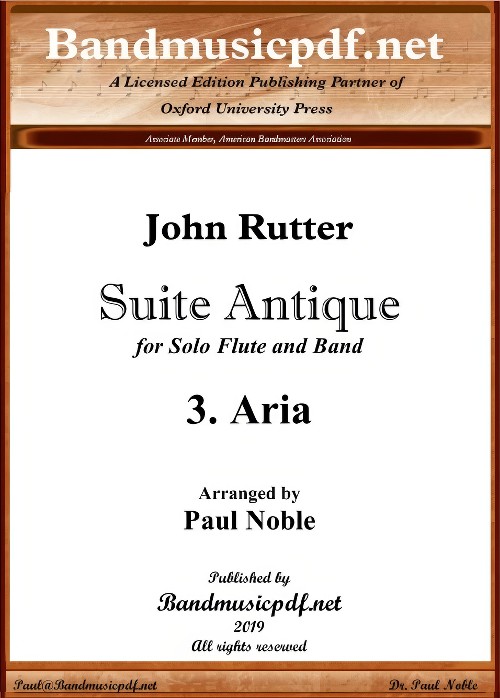 £75.00
£75.00Aria (from Suite Antique) (Flute Solo with Concert Band - Score and Parts) - Rutter, John - Noble, Paul
Suite Antique is a 1979 concertante work by John Rutter that is written for harpsichord, flute and string orchestra. Rutter composed the piece, in six movements, for a concert at which Bach's fifth Brandenburg concerto was to be performed, and so decided to write the piece for the same ensemble. This arrangement for Concert/Wind Band and Solo Flute adheres to the original presentation, but is expanded for a full band accompaniment to the solo flute. The harpsichord is optional, being cued elsewhere, but may be performed as in the original score by either harpsichord or an electronic keyboard with a similar setting. A jazz drumset is optionally included in the fourth (jazz waltz) movement, and other percussion discretely added in other movements. It is exciting to hear earlier musical forms brought into today's music appreciation, and this setting of a flute solo with band is especially refreshing for both soloist and band.
Estimated dispatch 7-14 working days
-
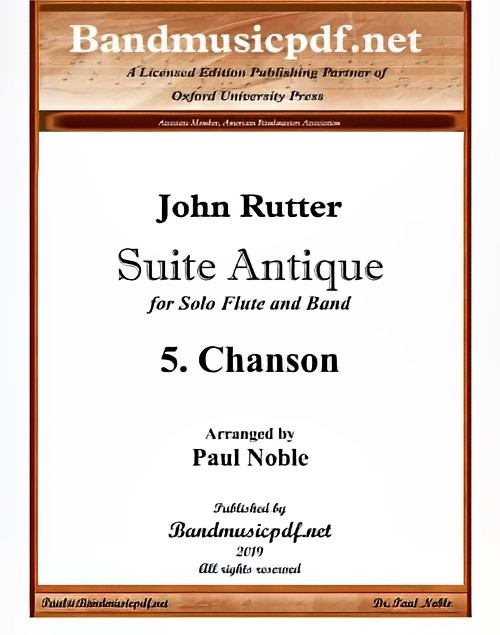 £95.00
£95.00Chanson (from Suite Antique) (Flute Solo with Concert Band - Score and Parts) - Rutter, John - Noble, Paul
Suite Antique is a 1979 concertante work by John Rutter that is written for harpsichord, flute and string orchestra. Rutter composed the piece, in six movements, for a concert at which Bach's fifth Brandenburg concerto was to be performed, and so decided to write the piece for the same ensemble. This arrangement for Concert/Wind Band and Solo Flute adheres to the original presentation, but is expanded for a full band accompaniment to the solo flute. The harpsichord is optional, being cued elsewhere, but may be performed as in the original score by either harpsichord or an electronic keyboard with a similar setting. A jazz drumset is optionally included in the fourth (jazz waltz) movement, and other percussion discretely added in other movements. It is exciting to hear earlier musical forms brought into today's music appreciation, and this setting of a flute solo with band is especially refreshing for both soloist and band.
Estimated dispatch 7-14 working days

